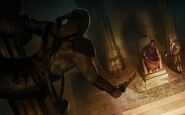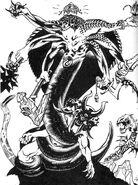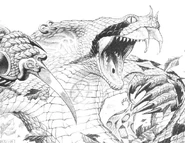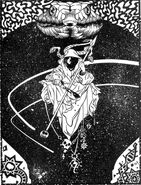Nagah are wereserpents, one of the surviving Changing Breeds of the Classic World of Darkness.
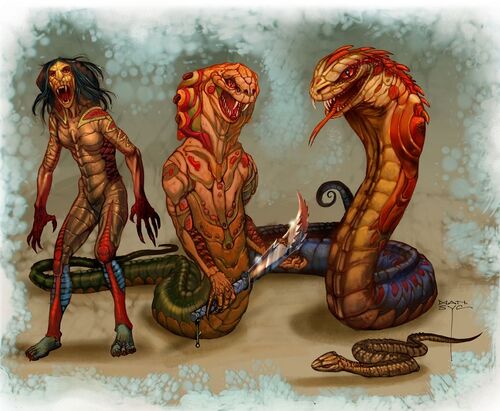
Overview

Symbol used by the Nagah to describe themselves
Most of the Fera consider the Nagah to be extinct, wiped out in the War of Rage; this is according to their plans, for they act as Gaia's "secret police", assassins and judges who target and eliminate those among the Fera who fall to corruption. The Nagah share the Garou's weakness against silver and their traits of Rage and Gnosis. The Nagah have a strong affiliation to water, which is shown in their amphibious snake forms and their aquatic Ananatas. Many spirits that are in league with them have also ties to this element.
Like other Changing Breeds, the Nagah are heirs to an instinctive language peculiar to their kind alone. However, the Nagah’s speech (called simply “the Tongue”) is much less reliant on vocalisation and more reliant on pheromone releases, body language, coil-shifting and the like. Thus, Nagah are able to communicate with one another even if the deaf Vasuki form. However, Nagah cannot communicate with ordinary serpents beyond the very basics of threat display and similar concepts; snakes simply don’t have the capacity for conversation.
The Nagah possess the best sensory abilities of human and snake - however, these abilities are often contradictory. A Nagah’s eyesight is passably accurate in all forms, and most Nagah have good colour vision even in Vasuki form. As the Nagah moves along the scale from Balaram to Vasuki, his senses of smell and taste become more and more acute. Unfortunately, the Nagah also suffer from the hearing problems common to their serpent Kin. Although a Nagah in Azhi Dahaka can hear about as well as an ordinary human, in Kali Dahaka the form has poor hearing. In Vasuki form a Nagah is deaf to any airborne sounds, and becomes reliant on his ability to sense vibrations and sound carried through solid objects.
The Nagah have access to a highly dangerous, fast poison, that has even effects on Leeches. In some cases, the Nagah may spit their venom in their opponents’ faces in order to blind them. In Vasuki or Kali Dahaka, only Nagah of spitting cobra stock can attempt this, but the versatile fangs of the Azhi Dahaka make spitting venom a possibility for all wereseprents. The venom cannot affect spirits, even materialised spirits. Other Nagah are immune to Nagah venom.
History
Although serpent-shifters appear here and there in tales and legends around the world - particularly in India - to the rest of the Changing Breeds, the Nagah are nothing more than a historical footnote. As the tales have it, the wereserpents were hunted to extinction during the War of Rage, and few shapeshifters miss them. The few tales of the Nagah that survive paint them as cold, aloof creatures that had no discernable purpose in Gaia’s plan - perhaps the most expendable casualty among the shapeshifter races. Some of the Garou will also claim that the Nagah were creatures of the Wyrm, due their affinity to snakes, and their destruction was justified.
But much of what is told about them is wrong. The Nagah share some common ancestors, the Dragon Kings, with the other reptilian shifters, the Mokole. When the world was young and the Age of Kings of the reptilian shapeshifters was on its peak, the Nagah were given the task of watching the other Changing Breeds, to make certain that their cousins performed their jobs fairly and well. They had no need to reward those faithful to Gaia and their duties - those that did well found reward enough. But those who betrayed their duties, who abused the trust given them - these shapeshifters were the true targets of the Nagah. For the Nagah had been given venom - and their job was to punish. During this time and the following age, the Nagah worked openly with their brethren.
Unfortunately, even the Nagah were not immune to corruption, and one of them fell to temptation at perhaps the worst possible time. As a result, the Nagah were unable to perform their duty sufficiently to prevent the War of Rage - and during the War of Rage, so many Nagah died that when the rest went into hiding, the other Changing Breeds were all too willing to believe the Nagah extinct.
However, the Nagah refused to let such a setback hinder the performance of their duty. They continued to silently monitor their shapeshifter cousins, marking those who betrayed their duties. Many of these criminals eventually met with a well-deserved fate at the claws of their own kind - but for those who seemed likely to escape justice, the Nagah were there.
The Nagah are not perfect. Even when they were at the height of their strength, they couldn’t punish every law-breaker or traitor. Many a shapeshifter has betrayed his ideals over the millennia and managed to live to laugh about it. But the Nagah refuse to give up on their duty; though it may seem hopeless, they will continue to avenge the most terrible sins until Apocalypse comes.
Breeds
- Balaram - the Human-born. In ancient times, many Balaram were nobles, but today other traits are more valued.
- Ahi - the Nagah-born. Unlike Garou, Nagah treat their metis as equals and revere them as unifiers.
- Vasuki - the Snake-born. They have the most troubles to adapt to their new forms.
Auspices
The Nagah don't orientate on the phases of Luna like other warm-blooded Fera, but instead have a seasonal auspice system that is very different from that of mammal-shifters.
- Kamakshi (Spring) - blessed by the forces of life and renewal, their element is earth.
- Kartikeya (Summer) - vigorous and true, their energy promotes the greatest passions to be found among the serpent people. Their element is fire.
- Kamsa (Autumn) - the mind of the target is their passion and their forté. Their element is air.
- Kali (Winter) - their blood is the coolest, their vision the truest, and their dedication to their cause knows no bounds. Their element is water.
Forms
- Balaram - indistinguishable from normal humans, though very few have much body fat
- Silkaram - almost human in appearance, but hair and skin are replaced with small scales, the face flattens and the eyes become more snake like, the teeth fuse together except for two fangs which retract like a cobras. In this form they gain a venom dangerous to mortals and even undead, though a vampire can spend blood to resist for each health level.
- Azi Dahaka - the combat form differs from Nagah to Nagah, but all have a massive hood like a cobra, many scar themselves to be more noticeable in this form, are able to unhinge their jaws, and have gills (they are fully amphibious in this form). The Nagah's mass increases but is due to a 16 to 20 foot tail for the lower half of the body, their arms become snakelike as they grow vertebrae instead of normal bones in their arms, allowing them to grapple more easily. The were-serpent’s hands sprout claws as terrible as those of any Garou, and their scales and scutes take on a supernatural resilience. Any scarification the Nagah has received stands out significantly in this form, often as patterns in the Azhi Dahaka’s scales. The Nagah causes the full Delirium effect in this form; few humans can stand to look on such an embodiment of their primal fear of snakes.
- Kali Dahaka - resembles a giant snake with two differences, and they are much larger than any normal cobra, and they have large venomous fangs. With a Primal-urge roll (difficulty 7), they can spurt a slender set of arms. This form also has gills and can breath under water.
- Vasuki - indistinguishable from a normal cobra, rattler, cottonmouth or other breed form.
Culture
The Nagah are ruled by a council of Elders called Sesha, who interprets the will of the Wani, the long-dead progenitors of the wereserpents. These councils- or Crowns- are one of the few ways of the Weresnakes to gain renown. From them, most nests also receive their orders.
Renown
Because the nests are nomadic, Nagah have to search for the Seshas to gain renown from them. The Sesha, after hearing of the deeds of the nest, decides which points of renown are given to them. This decides the rank and, in turn, the gifts a Nagah will learn. The renown systems uses Glory, Honor and Wisdom.
The Sacred Laws
Th Nagah have developed a code similar to the Litany.
- Preserve The Sacred Secret At All Cost: this Law maintains the secrecy of the Nagah in order to hide from the Fera who thought them extinct.
- Honor The Three Mothers: this Law is a reinforcement to the devotion that the Three Mothers (Gaia, Luna and Aspa) deserve and demand.
- Punish Those Who Betray The Laws: this Law is meant to clarify the purpose of the Nagah in Gaias plan.
- Never Hunt Alone: this Law details the main structure of a nest- one ahi, one vasuki, one balaram- in order to secure the proportion of judgement in a group. It also shall prevent that a Nagah is corrupted by the Wyrm because if this would happen, he would be put down instantly by his companion.
- Remain Humble: this Law remembers the Nagah that, by all their power, they are tools of the Three Mothers and should not overestimate them. Aside of this, the Nagah have experienced the follies of pride during the War of Rage and know how important it is to know their place.
- Abhor Imbalance: this Law reminds the Nagah that they must remain in balance, in body as well in spirit. There must always be a balance between the balaram, ahi and vasuki. Should the numbers of the breeds grow too far unbalanced, they must be set right.
- Strike Against The Corrupter If The Opportunity Is True: this Law is a recent addition and commands the Nagah to weaken the Wyrm, as long as they don't violate one of the other Laws and still fulfill their duties.
Gifts and Rituals
The Samskara (or rites) of the Nagah are notably different from those of the Garou. The most dramatic difference, of course, is that Nagah keep no caerns of their own, and therefore have no rites that might affect a caern’s disposition or fortunes. While the wereserpents recognise the value of caerns and their necessity to both Gaia and the Changing Breeds, and while the wereserpents occasionally act to punish those whose incompetence results in the loss of a caern, they do not believe that it is their place to create or use caerns. Nagah move around too much to protect a single caern, and their Samskara may be performed at a variety of places that, while not charged like caerns, are sacred to the wereserpents.
Without the need for caerns in the observance of Samskara, Nagah are free to hold their rituals wherever they choose. By far the most common setting for a Nagah Samskara is near a river. An island in the river is considered particularly auspicious, but Samskara may be held on the banks of a river or, in some cases, in the river itself. Other common sites for Nagah rituals are deep in tropical jungle, surrounded by their snake Kin or in the heart of a desert surrounded by great sand dunes and little else. Nagah prefer to perform Samskara at night by the light of the moon.
While rites, to the Garou, are often a time of social interaction, due to the nest structure most wereserpents organise themselves into, the Nagah concern themselves much, much less with the social elements of Samskara. Samskara are considered private, and performing them with anyone but one's own nestmates is awkward and embarrassing at best. With the exception of the Sesha conducting certain important rituals for a nest, it is a rare and somewhat uncomfortable thing for more than one nest to perform Samskara together.
Proper performance of the Samskara are an important element of virtuous living among the Nagah. There is very little emotion shown during Samskara, and they are exceedingly formal. Proper protocol and spirit etiquette are valued highly. Each movement or phrasing must be crisp and to the point. The core demands of Nagah Samskara are elegance and parsimony. Even if there is great emotion behind a rite, it always remains seething beneath the surface. Allowing raw emotion to flow out into a Samskara is considered an embarrassing breach of etiquette, though it is not commented on beyond that.
Repetition of mystically resonant phrases called mantras makes up a great deal of Nagah ritual. The ritemaster repeats the mantras of a given ritual until the words themselves lose meaning and hang in the minds of the nest like ungrounded aural objects.
Relationships with Others
The Nagah are unknown to a large portion of the other Changing Breeds - which they call Khurah. This is their plan, after the War of Rage (where they were targeted not only because of their position as the judges, but also because their snake-like appearance was mistaken for a connection to the Wyrm).
Now they act as the "secret police" among the other changers, watching and disposing of those changers who have gotten out of hand.
The Hush of the River
Errata and Clarifications
Renown
The Nagah actually do have a renown system that uses Glory, Honor and Wisdom, even though it does not truly rules how they gain rank, it does serve as a guideline. This was omitted from CB20 by purpose, but it may still be used by players and Storytellers. Note however that Nagah generally do not compare their renown with each other.
Nagah in the Umbra
The Nagah are rarely in the Umbra. Even the spirits think they are extinct, and the Naga wish to keep it that way. In their Kali Dahaka and Vasuki forms, most spirits will assume them to be snake spirits. In their Balaram and Silkaram forms, most spirits will mistake them for Mokolé.
Gallery
References
- WTA: Changing Breeds (book), p. 153-165
- WTA: Player's Guide to the Changing Breeds, p. 121 -129
- Breedbook: Nagah
| Werewolf: The Apocalypse Fera | |
|---|---|
| Gaian Breeds | Ajaba · Ananasi · Apis · Bastet · Camazotz · Corax · Garou · Grondr · Gurahl · Kitsune · Mokolé · Nagah · Nuwisha · Ratkin · Rokea |
| Wyrmish Breeds | Anurana · Kerasi · Samsa · Yeren |

